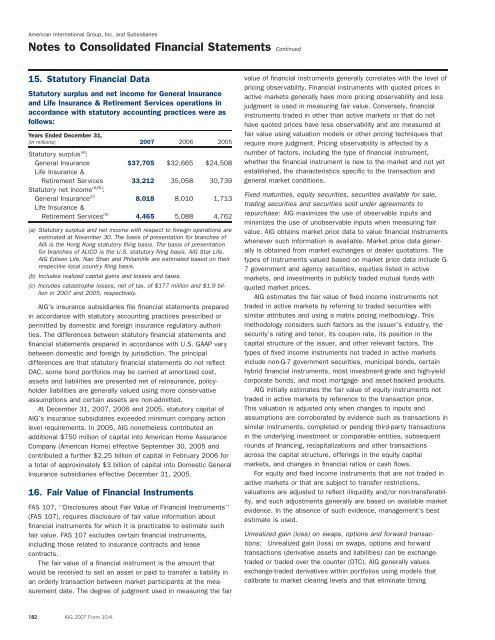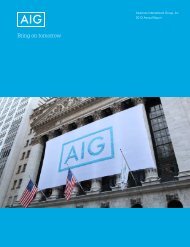2007 Annual Report - AIG.com
2007 Annual Report - AIG.com
2007 Annual Report - AIG.com
Create successful ePaper yourself
Turn your PDF publications into a flip-book with our unique Google optimized e-Paper software.
American International Group, Inc. and Subsidiaries<br />
Notes to Consolidated Financial Statements Continued<br />
15. Statutory Financial Data<br />
value of financial instruments generally correlates with the level of<br />
pricing observability. Financial instruments with quoted prices in<br />
Statutory surplus and net in<strong>com</strong>e for General Insurance active markets generally have more pricing observability and less<br />
and Life Insurance & Retirement Services operations in judgment is used in measuring fair value. Conversely, financial<br />
accordance with statutory accounting practices were as instruments traded in other than active markets or that do not<br />
follows:<br />
have quoted prices have less observability and are measured at<br />
Years Ended December 31,<br />
fair value using valuation models or other pricing techniques that<br />
(in millions) <strong>2007</strong> 2006 2005 require more judgment. Pricing observability is affected by a<br />
Statutory surplus (a) :<br />
number of factors, including the type of financial instrument,<br />
General Insurance $37,705 $32,665 $24,508 whether the financial instrument is new to the market and not yet<br />
Life Insurance &<br />
established, the characteristics specific to the transaction and<br />
Retirement Services 33,212 35,058 30,739 general market conditions.<br />
Statutory net in<strong>com</strong>e (a)(b) :<br />
Fixed maturities, equity securities, securities available for sale,<br />
General Insurance (c) 8,018 8,010 1,713<br />
trading securities and securities sold under agreements to<br />
Life Insurance &<br />
Retirement Services (a) 4,465 5,088 4,762<br />
repurchase: <strong>AIG</strong> maximizes the use of observable inputs and<br />
minimizes the use of unobservable inputs when measuring fair<br />
(a) Statutory surplus and net in<strong>com</strong>e with respect to foreign operations are value. <strong>AIG</strong> obtains market price data to value financial instruments<br />
estimated at November 30. The basis of presentation for branches of<br />
whenever such information is available. Market price data gener-<br />
AIA is the Hong Kong statutory filing basis. The basis of presentation<br />
for branches of ALICO is the U.S. statutory filing basis. <strong>AIG</strong> Star Life, ally is obtained from market exchanges or dealer quotations. The<br />
<strong>AIG</strong> Edison Life, Nan Shan and Philamlife are estimated based on their types of instruments valued based on market price data include G-<br />
respective local country filing basis.<br />
7 government and agency securities, equities listed in active<br />
(b) Includes realized capital gains and losses and taxes.<br />
markets, and investments in publicly traded mutual funds with<br />
(c) Includes catastrophe losses, net of tax, of $177 million and $1.9 bil- quoted market prices.<br />
lion in <strong>2007</strong> and 2005, respectively.<br />
<strong>AIG</strong> estimates the fair value of fixed in<strong>com</strong>e instruments not<br />
<strong>AIG</strong>’s insurance subsidiaries file financial statements prepared traded in active markets by referring to traded securities with<br />
in accordance with statutory accounting practices prescribed or similar attributes and using a matrix pricing methodology. This<br />
permitted by domestic and foreign insurance regulatory authorisecurity’s<br />
methodology considers such factors as the issuer’s industry, the<br />
ties. The differences between statutory financial statements and<br />
rating and tenor, its coupon rate, its position in the<br />
financial statements prepared in accordance with U.S. GAAP vary capital structure of the issuer, and other relevant factors. The<br />
between domestic and foreign by jurisdiction. The principal<br />
types of fixed in<strong>com</strong>e instruments not traded in active markets<br />
differences are that statutory financial statements do not reflect include non-G-7 government securities, municipal bonds, certain<br />
DAC, some bond portfolios may be carried at amortized cost, hybrid financial instruments, most investment-grade and high-yield<br />
assets and liabilities are presented net of reinsurance, policy- corporate bonds, and most mortgage- and asset-backed products.<br />
holder liabilities are generally valued using more conservative<br />
<strong>AIG</strong> initially estimates the fair value of equity instruments not<br />
assumptions and certain assets are non-admitted.<br />
traded in active markets by reference to the transaction price.<br />
At December 31, <strong>2007</strong>, 2006 and 2005, statutory capital of This valuation is adjusted only when changes to inputs and<br />
<strong>AIG</strong>’s insurance subsidiaries exceeded minimum <strong>com</strong>pany action assumptions are corroborated by evidence such as transactions in<br />
level requirements. In 2005, <strong>AIG</strong> nonetheless contributed an similar instruments, <strong>com</strong>pleted or pending third-party transactions<br />
additional $750 million of capital into American Home Assurance in the underlying investment or <strong>com</strong>parable entities, subsequent<br />
Company (American Home) effective September 30, 2005 and rounds of financing, recapitalizations and other transactions<br />
contributed a further $2.25 billion of capital in February 2006 for across the capital structure, offerings in the equity capital<br />
a total of approximately $3 billion of capital into Domestic General markets, and changes in financial ratios or cash flows.<br />
Insurance subsidiaries effective December 31, 2005.<br />
For equity and fixed in<strong>com</strong>e instruments that are not traded in<br />
active markets or that are subject to transfer restrictions,<br />
16. Fair Value of Financial Instruments<br />
valuations are adjusted to reflect illiquidity and/or non-transferability,<br />
and such adjustments generally are based on available market<br />
FAS 107, ‘‘Disclosures about Fair Value of Financial Instruments’’<br />
evidence. In the absence of such evidence, management’s best<br />
(FAS 107), requires disclosure of fair value information about<br />
estimate is used.<br />
financial instruments for which it is practicable to estimate such<br />
fair value. FAS 107 excludes certain financial instruments,<br />
Unrealized gain (loss) on swaps, options and forward transac-<br />
including those related to insurance contracts and lease<br />
tions: Unrealized gain (loss) on swaps, options and forward<br />
contracts.<br />
transactions (derivative assets and liabilities) can be exchange-<br />
The fair value of a financial instrument is the amount that traded or traded over the counter (OTC). <strong>AIG</strong> generally values<br />
would be received to sell an asset or paid to transfer a liability in exchange-traded derivatives within portfolios using models that<br />
an orderly transaction between market participants at the measurement<br />
calibrate to market clearing levels and that eliminate timing<br />
date. The degree of judgment used in measuring the<br />
fair<br />
182 <strong>AIG</strong> <strong>2007</strong> Form 10-K

















